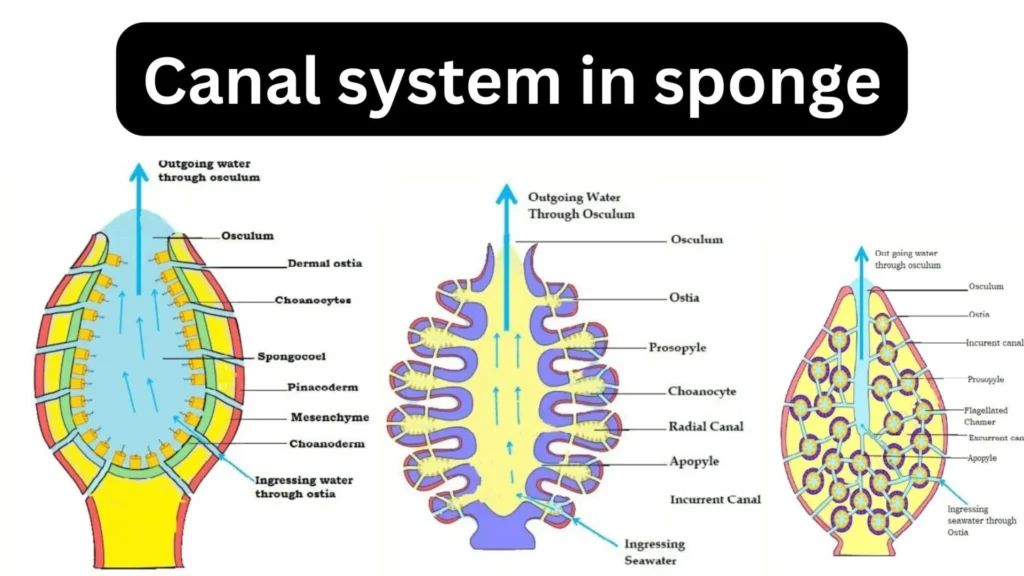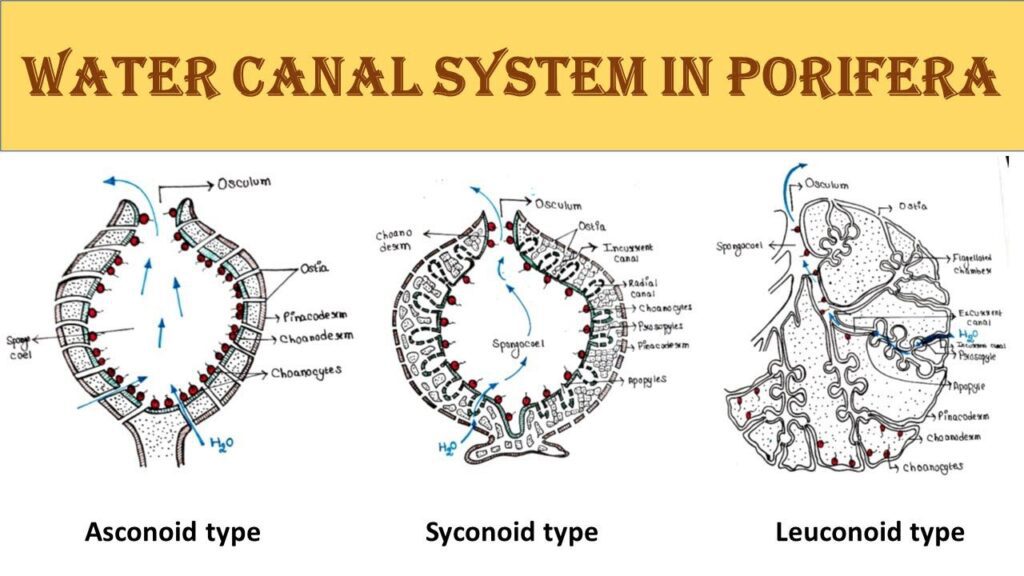Introduction
When we think of animals, we often picture creatures that move, eat, hunt, or fly. But not all animals are like that. Some are so simple that they don’t even have organs, tissues, or a nervous system. They look more like colorful rocks stuck to the ocean floor than living creatures.
Welcome to the fascinating world of Porifera—commonly known as sponges.
Porifera is the simplest and most primitive group of multicellular animals. Although they seem lifeless at first glance, they play a critical role in aquatic ecosystems and have unique biological features that make them truly special.
Table of Contents
Meaning of the Word ‘Porifera’
The term “Porifera” comes from Latin:
- “Pori” = pores
- “Fera” = bearing or having
So, Porifera means “pore-bearing animals.” These pores cover their body surface and help them in filter feeding, which is how they get their food.

General Characteristics of Phylum Porifera
The characteristics of phylum porifera are as follows.
1. Habitat
- Almost all Porifera are aquatic, and most are marine (live in saltwater).
- Only a few species live in freshwater (e.g., Spongilla).
2. Body Symmetry
- Most sponges are asymmetrical (no specific shape).
- Some may show radial symmetry (body arranged around a central axis).
3. Body Organization
- They have a cellular level of organization, meaning their bodies are made of loosely arranged cells.
- There is no tissue, no organs, and no organ systems.
4. Body Structure
- The sponge body is like a hollow sac or cylinder with many tiny pores on the surface (called ostia) and usually one large opening at the top (called osculum).
- Water enters through the ostia and exits through the osculum.
5. Skeleton
- Sponges have an internal skeleton made up of:
- Spicules (made of silica or calcium carbonate) OR
- Spongin fibers (a protein-based soft material)
6. Feeding and Digestion
- Sponges are filter feeders. They draw water in through their pores, trap tiny food particles (like plankton), and then expel the water.
- Digestion is intracellular, meaning it happens inside individual cells.
7. Circulation and Excretion
- Sponges do not have a circulatory, respiratory, or excretory system.
- All functions like gas exchange and waste removal occur by diffusion through the water that flows inside their body.
8. Nervous System and Sensory Organs
- They lack a nervous system. However, they can respond to stimuli in a very basic way (e.g., closing their pores if irritated).
9. Reproduction
- Asexual reproduction:
- By budding or fragmentation
- By gemmules (special internal buds in freshwater sponges used for survival in harsh conditions)
- Sexual reproduction:
- Most are hermaphrodites (have both male and female reproductive cells)
- Fertilization is usually internal
- Larva is free-swimming, while adults are sessile (fixed in one place)
10. Regeneration
Sponges have amazing regenerative power. If a sponge is cut into pieces, each piece can grow into a new sponge.
Structure of a Typical Sponge (Canal System)

One of the most unique features of sponges is their canal system—a network of water channels that allows water to circulate through the sponge body. This system is essential for feeding, respiration, and waste removal.
Types of Canal Systems:

- Asconoid – Simplest type, with a tube-like shape.
- Syconoid – Wall is folded to increase surface area.
- Leuconoid – Most complex and efficient; found in most modern sponges.
Water flows through:
Ostia → Canals and chambers lined with choanocytes (collar cells) → Osculum
Cell Types in Sponges
Sponges have a variety of specialized cells, including:
- Pinacocytes – Flat cells forming the outer layer.
- Choanocytes (Collar cells) – Line the inner chambers, capture food, and generate water current.
- Amoebocytes – Move through the body and transport nutrients; also help in producing spicules and spongin.
- Porocytes – Tubular cells that form pores for water entry.
Classification of Phylum Porifera
Phylum Porifera is divided into three main classes based on the type of skeleton they have.
1. Class Calcarea (Calcareous Sponges)
Characteristics:
- Skeleton made of calcium carbonate (CaCO₃) spicules
- Small in size
- Have asconoid, syconoid, or leuconoid canal systems
- Usually found in shallow marine water
Examples:
- Leucosolenia
- Sycon (also known as Scypha)
- Grantia
2. Class Hexactinellida (Glass Sponges)
Characteristics:
- Skeleton made of siliceous spicules (often six-rayed, hence “hexactine”)
- Spicules are often fused to form a glass-like lattice
- Deep-sea marine sponges
- Body often cylindrical or funnel-shaped
- Canal system is syconoid or leuconoid
Examples:
- Euplectella (Venus’ Flower Basket)
- Hyalonema
3. Class Demospongiae (Horny or Siliceous Sponges)
Characteristics:
- Skeleton made of spongin fibers, siliceous spicules, or both
- Leuconoid canal system (most complex)
- Includes freshwater and marine species
- Largest and most diverse group (90% of all sponge species)
Examples:
- Spongilla (freshwater)
- Euspongia (bath sponge)
- Cliona (boring sponge)
Ecological and Economic Importance of Sponges
Ecological Roles:
- Filter large amounts of water, maintaining water quality
- Provide habitat for small marine organisms
- Play a role in nutrient cycling in oceans
Economic Importance:
- Used as natural bath sponges (mainly Euspongia)
- Research in medicine: sponge compounds may have anti-cancer, anti-viral, or antibacterial properties
- Act as bioindicators of water quality
Interesting Facts About Sponges
- Some sponges can live for thousands of years, making them among the longest-living animals.
- A single sponge can filter hundreds of liters of water per day.
- Despite having no brain or nerves, sponges can coordinate their pores to control water flow.
Summary Table: Classification of Porifera
| Class | Skeleton Type | Canal System | Habitat | Examples |
|---|---|---|---|---|
| Calcarea | Calcium carbonate | Asconoid/Syconoid/Leuconoid | Marine | Leucosolenia, Sycon |
| Hexactinellida | Siliceous (6-rayed) | Syconoid/Leuconoid | Deep sea | Euplectella, Hyalonema |
| Demospongiae | Spongin and/or siliceous | Leuconoid | Marine & Freshwater | Spongilla, Euspongia |
Conclusion
Sponges (Phylum Porifera) may seem like simple creatures, but they are incredibly fascinating and important in both nature and science. Their simple structure, unique way of feeding, ability to regenerate, and diverse forms have made them a key group in understanding early animal evolution.
Despite lacking organs, nerves, or a brain, sponges continue to surprise scientists with their abilities and hidden complexity. From cleaning ocean water to helping create life-saving medicines, these “living filters” are silent but powerful members of the animal kingdom.
FREQUENTLY ASKED QUESTIONS
What is phylum porifera ?
Phylum Porifera is a group of simple, aquatic animals commonly known as sponges. The name “Porifera” means “pore-bearing,” referring to the many tiny holes (called ostia) on their body surface.
What is canal system in porifera ?
The canal system in Porifera is a network of water channels and chambers found inside the body of sponges. This system helps them circulate water through their bodies so they can breathe, feed, remove waste, and reproduce—all without any organs.
Is porifera diploblastic ?
Porifera are considered diploblastic because they have two main cell layers an outer layer (pinacoderm) and an inner layer (choanoderm) but they lack true tissues and germ layers found in more advanced animals.
Related Articles




